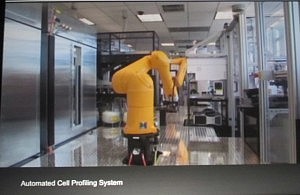AACR 2012: the automation of preclinical drug discovery will be a driver of innovation
There was so much good science on display at the recent 2012 annual meeting of the American Association for Cancer Research (AACR) in Chicago that any blog posts are but a personal snapshot or postcard.
 One enduring image I have from the plenary presentation on “The Genetic Basis for Cancer Therapy” by Bill Sellers, VP/Global Head Oncology at Novartis Institutes for BioMedical Research was the video he showed of the robots that are used for automated cell profiling.
One enduring image I have from the plenary presentation on “The Genetic Basis for Cancer Therapy” by Bill Sellers, VP/Global Head Oncology at Novartis Institutes for BioMedical Research was the video he showed of the robots that are used for automated cell profiling.
Imagine the advertisements that show robots being used to build cars, but now the robots are undertaking automated laboratory work in pursuit of new cancer compounds. Wow!
During his presentation, Sellers described how Novartis have built a robust preclinical translational infrastructure.
He went on to say that, “many experiments we have done in the past, and even many molecules that were put in the human, really were only profiled against a limited number of preclinical models such as one cell line.”
In order to make preclinical data more reproducible, Novartis had the goal to move from testing against one cell line to testing against an encyclopedia of cell lines.
This has now become a reality with the launch of the Cancer Cell Line Encyclopedia (CCLE) in collaboration with the Broad Institute. The CCLE was recently announced by Novartis in a media release, and details were published online on March 28, 2012 in a letter to “Nature” (doi:10.1038/nature11003).
The Cancer Cell Line Encyclopedia enables predictive modelling of anticancer drug sensitivity
As described in “Nature”:The Cancer Cell Line Encyclopedia (CCLE) is a compilation of gene expression, chromosomal copy number and massively parallel sequencing data from 947 human cancer cell lines.
When coupled with pharmacological profiles for 24 anticancer drugs across 479 of the cell lines, this collection allowed identification of genetic, lineage, and gene-expression-based predictors of drug sensitivity.”
Sellers noted in his AACR plenary presentation that the key to using the CCLE is for profiling and to:
“identify subsets of cancer cell lines that are sensitive to a given therapeutic versus those that are not. And then better yet to identify the markers of sensitivity that are differentially expressed or present in the sensitive versus insensitive cell lines.”
 To do this, Sellers described how Novartis have built a robotic system that e.g. automates cell profiling. In approx 3 months with this system we can profile 600 cell lines for about 1500 compounds, he said.
To do this, Sellers described how Novartis have built a robotic system that e.g. automates cell profiling. In approx 3 months with this system we can profile 600 cell lines for about 1500 compounds, he said.
This type of preclinical automation is speeding up cancer drug discovery through the ability to more rapidly identify those compounds that are associated with and have activity against different mutations.
In my view, this will drive innovation through the effective and efficient screening of potential new cancer compounds, with the result that only those compounds with demonstrable promise progress.
AACR have made Bill Sellers plenary presentation available as a free webcast from the 2012 annual meeting (along with several others). I encourage anyone interested in how cancer biology is driving cancer drug development to watch this.